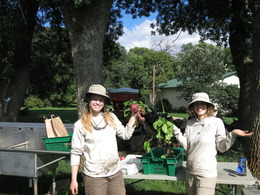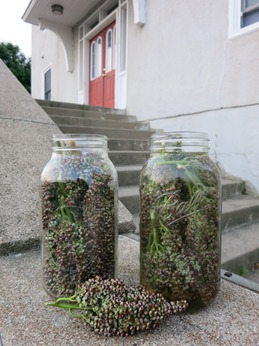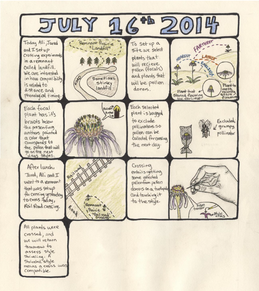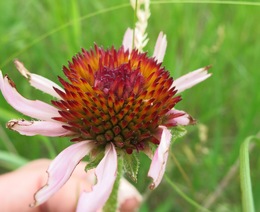|
|
As summer draws to a close, this past weekend was spent doing what anyone does at the end of growing seasons, canning and harvesting Echinacea heads.
We’ve been a part of a CSA during the end of the summer, and have been delighted by the abundance and deliciousness of the produce we have received so far. The farm, Lakeside Prairie farm (http://www.lakesideprairiefarm.com), believes in sharing the abundance of the harvest. We have been able to come out a couple times over the season and harvest whatever they have extra of as part of our CSA. This is where I got beets and green beans to can, as well as cucumbers to pickle and lots of cabbage for sauerkraut.
Pictured below, Maureen and Elizabeth enjoying the plentiful harvest at the farm.

To bring the Wagenius’s canning pot back home I retrieve it via bike, which earned me some puzzled stares from drivers on the road.

Along with canning, we’re also occupied with Echinacea head harvesting. So far we’ve done a first round of harvesting at Staffanson Prairie Preserve and a third round at P1 and P2. We see more canning and head harvesting in our near future.
-Claire
While gazing up from measuring Dichanthelium today I spotted a large patch of fruiting sumac. The past summer I had been itching to make some sumac lemonade, and the abundant stand of smooth sumac (Rhus glabra) presented an irresistible opportunity!
After a quick and easy harvest of the fruits (called drupes) that are found in compound clusters at the end of branches, some team members and I returned for brewing.
There are many methods for making sumac-ade on the world wide web. The variables are sumac berries on or off the stem, the temperature of the water, and the duration of the soaking time. I decided to try out two at first, both leaving the fruits on the stem, one adding cold water and a longer wait time, and one where hot water is added and steeping only lasts 30 minutes. (Sumac is pictured below, jars thanks to Gretel and Stuart)

After many test rounds, two taste testers and I agree that the colder, longer brew time results in a more palatable, tart, and less bitter final product. The hotter, shorter method heats up the stems and causes them to release bitter sap. (In the picture below the sumac in the jar on the right was submerged in boiling water, and it is actively releasing sap).

Future projects include sumac-ade popsicles, as well as fruit drying for winter use and spice grinding.
In case you’re missing the exciting happenings at Staffanson Prairie Preserve, here’s the first issue of The Staffanson Almost Weekly. This periodical will keep you up to date on the new plant of the week, a plant that is nearing the end of it’s flowering period, and one that will most likely begin to bloom in the next week (all voted on by Claire and Jared). There are also some other exciting tidbits about current experiments and other interesting sightings.
-Claire

Today Jared, Will and I spent the afternoon at Staffanson Prairie Preserve wrangling the blooming Echincea with flags and twist ties while also updating our flowering map of 2014. We’re working to find plants that were used in phenology studies in previous years so we can look at how a single plant’s flowering pattern changes over time. Here’s a map of the plants we’ve found so far this year, overlaid on multiple years of previously mapped plants.
staffmap.pdf
While out and about in Staffanson it’s easy to get drawn into the morphing landscape as new species begin to bloom. Here’s a picture of one of our favorites, Delphinium carolinianum.

It’s been a day full of giddy excitement for Team Echinacea. Not only was it a team member’s birthday, but on our first trip to the remnants we found the first flowering head of the season.
If you look carefully at the picture below you can see the first style on the bottom right.

This plant is number 1414, first tagged in 1997 in the KJ remnant. The upper florets on 1414 are not typical in form, and appear to be diseased. Bets are still on for the first flowering head in the experimental plots.
-Claire
Hello Floggers! My name is Claire Ellwanger and I’m excited to be a part of Team Echinacea this summer. Since graduating from Bowdoin College in 2012 I’ve spent the past two years gaining experience in the field of plant biology and conservation in Maine, California, and Puerto Rico. I’m already enjoying time in the mid-west getting to know prairie plants and how their reproductive success is impacted by habitat fragmentation. More about me and my research this summer can be found on the Echinacea Project website.

|
|










